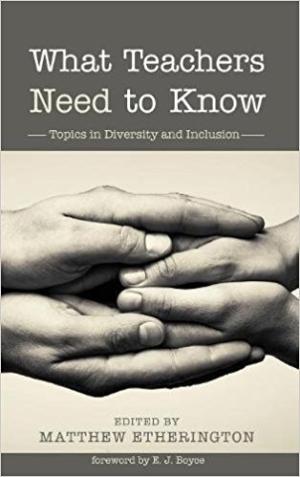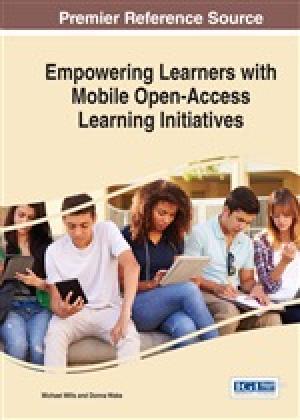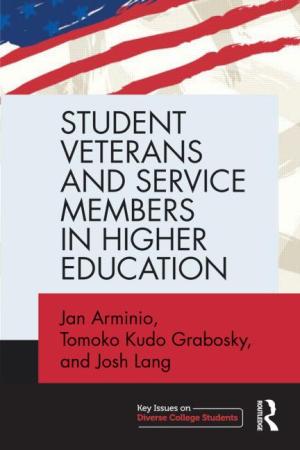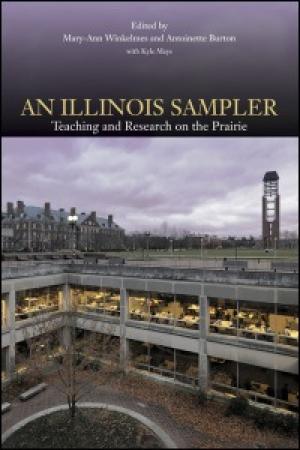Resources by Christina Geuther

What Teachers Need to Know (Etherington, 2017) is a substantial text defining the diverse and inclusive experiences of contemporary education systems. The book is a compilation with three major parts: “Ethics,” “Inclusion and Teacher Management,” and “Worldview and Story.” Each chapter provides reading questions for use in a classroom setting or for deeper reflection. This is well-suited for an audience in higher education, especially for readers who could share personal experiences with diversity and inclusion topics after a practicum or time teaching. I would recommend this book for a post-graduate education library. The first part, “Ethics,” includes works by Sherick Hughes, Martyn Rouse, Jonathan Anuik, Chet Bowers, Eva Maria Waibel, the editor, Matthew Etherington, and James Dalziel. There is quite a range of topics in this section, but the Wabash Center reader might be particularly interested in Anuik's essay on faith-informed discourse. It is a study about the influence of missionary education on Indigenous beliefs, and how that reaches into Canadian public education today. It compels the reader to contemplate whether church and state can truly be separate in an educational context when there is such a significant inheritance of practice and values from a period dominated by religious influence. Part Two, “Inclusion and Teacher Management,” includes works by Peter J. Froese, Ken Pudlas, Lucinda Spaulding, Karen Copeland, Bruce Shelvey, and Ken Bradley. Spaulding's essay reflects the current shift of attention to patterns of bullying and puts forward the mechanisms school communities can provide for the resiliency of the students. Other essays in this section discuss topics such as mental health, special needs, and even bring in the parents' view on these issues as they exist in the educational system. This is an exceptional collection of essays on inclusivity. The third and final part, “Worldview and Story,” includes works by the editor, Matthew Etherington, Edward R. Howe, Adam Forsyth, Leo Van Arragon, Christina Belcher, and Cynthia à Beckett. This section has the most obvious correlation to religious studies within educational contexts. Topics include: tolerance, science and religion, and epistemology. This section could serve as an excellent initial reading for students in a practical theology or other contemporized religious studies capstone course. This book might not be a comfortable read in a public classroom, but maybe that is exactly why it should be read. Etherington's compilation offers academic theological reflection for secularized educational contexts. This book could be useful in a range of contexts. It may be particularly helpful to new teachers, parent associations, pastors of students, and community leaders.

Empowering Learners with Mobile Open-Access Learning Initiatives is a well-designed book giving an overview and awareness to mobile activities as they can be provided in an educational setting. The anthology was compiled by Michael Mills and Donna Wake, both from the University of Central Arkansas. Most of the studies are North American, but there is ample diversity of circumstances in the populations studied and techniques showcased. The book is separated into four parts: practice, curriculum, assessment, and theory. This book will likely become a historic piece of educational observation on today’s environment, but just as importantly, it is future-looking. So how is the future looking? The authors are clearly optimistic about the future of higher education. The evidence shows the effectiveness of mobile technologies to provide a more equal and motivated voice in society. Considering the Wabash Center for Teaching in Learning in Theology and Religion’s audience, this book would be most effective for those in curriculum development and assessment. It is easy to read, but scientifically formatted. Each chapter constitutes a separate study contributing to the overall discussion, and new vocabulary is introduced and defined at the conclusion of each chapter. The publisher, IGI Global, is an established publisher of Information Science and this text could be useful even as a textbook for courses in Information Science and Technology. The book could have been enhanced through a greater diversity of authorship and a wider distribution of geographical locations. Mobile technology is world-reaching, but much of this book’s arguments were grounded in a Western cultural understanding of the world. It would have been helpful for that to have been disclosed in the preface as a both a limitation of this volume and a signal for further study about student learning in online open-access models of education. There was some effort by the authors to attend to issues related to physical and learning disabilities and learning needs of underprivileged communities. However, the only examples the authors provide outside of the United States were Kenya and Portugal. The real value of the book is its comprehensive structure of presentation and approach to mobile technology as a discipline. It does not make light of the common lay person’s experience with mobile technology. Rather, there is a sense of power behind today’s and the future’s possibilities for reducing social barriers in education. Empowering Learners with Mobile Open-Access Learning Initiatives would be an excellent contribution to a higher education library, and that is said without hesitancy even when the examples of technology in the book could be somewhat fleeting given the rapid changes in technology and online learning.

Arminio, Grabosky, and Lang (2015) provide a comprehensive overview of student veterans and service members from interviews and analyses of higher education institutions. This book speaks from history and experience of the U.S. military to present outreach opportunities for the modern reader. The best audience for this book would be higher education administrators and counselors because it primarily discusses the challenges of transitioning to student life in higher education. More importantly, the authors consider the life of the students beyond school, what the students have seen, the makeup of the military world, and how it sheds light on this one. The study consisted of semi-structured interviews of sixteen higher education employees and fourteen students, and included a military spouse, and students at a community college and a public research-intensive institution with multiple campuses. Although this is a small set from which to draw specific conclusions, the volume provides valuable insights about service veterans and members enrolled in higher educational contexts. Student veteran and service members did not have direct support services at the research-intensive institution until after 9/11. The book documents how this change came about when students organized themselves and the campuses responded. The authors provide helpful lists of behaviors of facilitation (53) and advocacy of the student (61) and the system (65). Drawing on an advocacy model put forth by Lewis, Arnold, House, and Torporek (2002) of the American Counseling Association, Arminio, Grabosky, and Lang describe best practices in higher education for this target student group. For example, there should be regular review of degree progress corresponding to military financial benefits and possible deployment. The authors also give weight to possible needs for counseling and disability services. The three predominant cultural transitions between the military and higher education are the loss of collectivism, hierarchy, and masculinity. According to the study, student veteran and service members perceive themselves as outsiders in this environment (105). At the same time, "the military experience influences the college experience, but how it does depends on the individual and his or her experiences and contexts" (106). While the U.S. military is historically less tolerant of the LGBT community, one student participant in the study who identified as a lesbian felt accepted by her military colleagues (107). Higher education could further offer her the advocacy available at campus LGBT resource centers (89). If we continue to take her example, she still might find the individualistic culture of academics as a source of isolation when she once found quick comradery in the military world. A few of the interviews in the study mention that academics are a source of concern because they differ from the hierarchy and structure of the military in their exercise of power as teachers, with one person commenting that they prefer instructions for assignments to be more direct about resources and expected outcomes. A lack of specific directions can be disconcerting to past and present military-related students. Although the book gives insight into specific teaching styles for student veterans and service members transitioning into higher educational contexts, it does not offer as much as it might. On the whole, the book is geared toward the student as a part of the higher education community.

While this book is dedicated to students, chapters showcase the dedication of professors to providing effective learning formats in diverse fields. An Illinois Sampler: Teaching and Research on the Prairie highlights teaching methods at the University of Illinois that can be applied elsewhere. It would be an excellent book for a new professor, including one looking for field opportunities for their students. The nineteen chapters are very short, but in essence provide quickly consumable case studies of everything from inmate education and research abroad to flipped classrooms and the standard lecture format. It would work well for a small group discussion of education students who could read it together while in session. Topics for small group discussion could include holistic education, teaching from the sciences and humanities, and student-centered learning. Higher education administrators might also appreciate an overview of some of the programs at the University of Illinois. However, these chapters are just glimpses of the authors’ insights; some readers might need to pursue further research. Examples like Rosu’s highlights of the iFoundry program created by the engineering faculty and Denofrio-Corrales and Lu’s innovative Chemistry and Biology of Everyday Life (CBEL) course structure organize around students’ interests. Precisely how they do it could be the theme for another book. Instead of a recipe, we are given a taste of the passion and flavor of University of Illinois teaching practices. This book is dedicated to students. The authors capture a learning environment that alumni and current students can be proud of, but the Illinois Sampler shows that across the spectrum, the professors dedicate their work to their students. In pages of reflection by faculty in the humanities and sciences serving traditional and nontraditional students, teaching with traditional and nontraditional methods, An Illinois Sampler teaches what it means to teach: It is a statistics professor trying to make numbers lead to a better quality of life. It is a lecturer uncovering the living complexity of once simple fairy tales. It is an education behind bars professor who liberates minds. It is the professor learning from collaboration with their students, and reigniting a teaching passion for and by them. This book acts as a sampler in its composition, moving from highlights in music to math to literature to science to dance. Unconventionally juxtaposed, one discipline does not outweigh the other. Everyone will be able to find something appealing in it because of the broad inclusion, and, readers will gain knowledge from perspectives across disciplines. It should also be noted that contributors “vary not only by expertise but also in age, gender, nationality, career stage, and even their position in the academic hierarchy” (ix). The real success of this book is the variety. An Illinois Sampler is both a recommended read and endeavor.